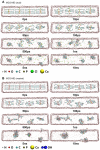Influence of Acidic Environment on Hydrolytic Stability of MDP-Ca Salts with Nanolayered and Amorphous Structures
- PMID: 35444417
- PMCID: PMC9014115
- DOI: 10.2147/IJN.S357823
Influence of Acidic Environment on Hydrolytic Stability of MDP-Ca Salts with Nanolayered and Amorphous Structures
Abstract
Purpose: This study aimed to investigate the hydrolytic stability of 10-methacryloyloxydecyl dihydrogen phosphate calcium (MDP-Ca) salts with nanolayered and amorphous structures in different pH environments.
Methods: The MDP-Ca salts were synthesized from MDP and calcium chloride and characterized by X-ray diffraction (XRD), nuclear magnetic resonance (NMR), and transmission electron microscopy (TEM). Inductively coupled plasma-mass spectrometry (ICP-MS) was used to quantify the release of calcium from the synthesized MDP-Ca salt, MDP-treated hydroxyapatite (MDP-HAp), and untreated HAp after soaking in acidic and neutral solutions for 1, 7, and 30 days. To study the hydrolytic process, we carried out molecular dynamics (MD) simulations of the nanolayered MCS-MD (monocalcium salt of the MDP dimer) and DCS-MD (dicalcium salt of the MDP dimer) structures, as well as of the amorphous-phase MCS-MM (monocalcium salt of the MDP monomer).
Results: The TEM images showed that the nanolayered structures were partially degraded by acid attack. Based on the ICP-MS results, the hydrolysis rate of the MDP-Ca salt in acidic and neutral environments followed the order HAp > MDP-HAp > MDP-Ca salt. The MD simulations showed that, in acidic environments, clusters of MDP remained aggregated and all Ca2+ ions separated from the MDP monomer to interact with water molecules in aqueous solution. In neutral environments, Ca2+ ions always interacted with phosphate groups, OH- ions, and water molecules to form clusters centered on Ca2+ ions.
Conclusion: MDP-Ca presented higher hydrolysis rates in acidic than neutral environments. Nanolayered MCS-MD possessed the highest resistance to acidic hydrolysis, followed by amorphous MCS-MM and DCS-MD.
Keywords: 10-methacryloyloxydecyl dihydrogen phosphate calcium salts; dentin bonding; hydrolysis; molecular dynamics simulations; nanolayering.
© 2022 Zhao et al.
Conflict of interest statement
The authors report no conflicts of interest in this work.
Figures









Similar articles
-
Layering mechanism of MDP-Ca salt produced in demineralization of enamel and dentin apatite.Dent Mater. 2017 Jan;33(1):23-32. doi: 10.1016/j.dental.2016.09.037. Epub 2016 Oct 20. Dent Mater. 2017. PMID: 27773341
-
Quantitative Evaluation of MDP-Ca Salt and DCPD after Application of an MDP-based One-step Self-etching Adhesive on Enamel and Dentin.J Adhes Dent. 2016;18(3):205-13. doi: 10.3290/j.jad.a36133. J Adhes Dent. 2016. PMID: 27200430
-
The roles of 10-methacryloyloxydecyl dihydrogen phosphate and its calcium salt in preserving the adhesive-dentin hybrid layer.Dent Mater. 2022 Jul;38(7):1194-1205. doi: 10.1016/j.dental.2022.06.007. Epub 2022 Jun 15. Dent Mater. 2022. PMID: 35715248
-
Effects of Solvents and pH Values on the Chemical Affinity of 10-Methacryloyloxydecyl Dihydrogen Phosphate toward Hydroxyapatite.ACS Omega. 2021 Jul 17;6(29):19183-19193. doi: 10.1021/acsomega.1c02521. eCollection 2021 Jul 27. ACS Omega. 2021. PMID: 34337256 Free PMC article.
-
Determination of molecular species of calcium salts of MDP produced through decalcification of enamel and dentin by MDP-based one-step adhesive.Dent Mater J. 2015;34(2):270-9. doi: 10.4012/dmj.2014-260. Epub 2015 Mar 4. Dent Mater J. 2015. PMID: 25753080
Cited by
-
15-Methacryloyloxypentadecyl Dihydrogen Phosphate Improves Resin-to-Zirconia Bonding Durability.J Adhes Dent. 2023 Jan 23;25:23-30. doi: 10.3290/j.jad.b3831385. J Adhes Dent. 2023. PMID: 36689275 Free PMC article.
-
An In Vitro Exploration of Interaction Mechanisms of Intracoronal Bleaching on the Compressive Strength of Conventional and Calcium Silicate-Based Self-Adhesive Resins and Their Bonding to Composite Resin Restorative Material.Int J Dent. 2024 Oct 22;2024:6645237. doi: 10.1155/2024/6645237. eCollection 2024. Int J Dent. 2024. PMID: 39474036 Free PMC article.
-
Bond Strength and Adhesion Mechanisms of Novel Bone Adhesives.Bioengineering (Basel). 2023 Jan 6;10(1):78. doi: 10.3390/bioengineering10010078. Bioengineering (Basel). 2023. PMID: 36671649 Free PMC article.
References
MeSH terms
Substances
LinkOut - more resources
Full Text Sources
Miscellaneous

